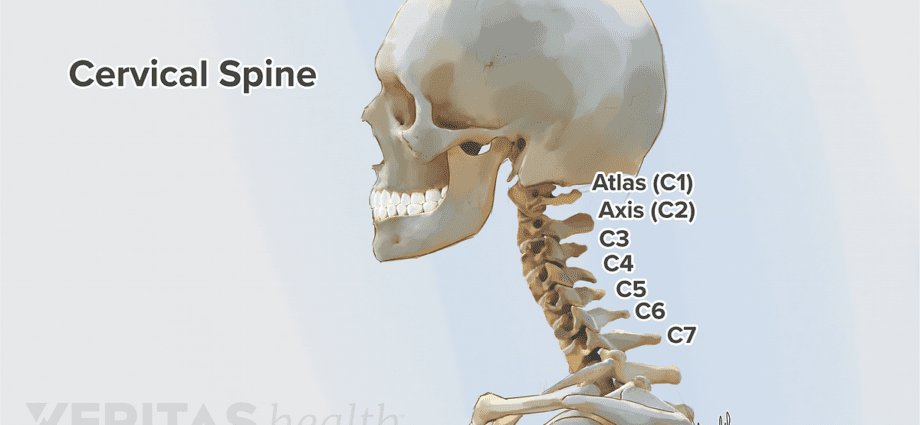Contents
Cervical vertebrae
The cervical vertebrae make up a part of the spine.
Anatomy
Position. The cervical vertebrae form part of the spine, or spine, a bone structure located between the head and the pelvis. The spine forms the skeletal base of the trunk, located dorsally and along the midline. It starts under the skull and extends into the pelvic region (1). The spine is made up of an average of 33 bones, called vertebrae (2). These bones are linked together to form an axis, which has a double S shape. The cervical vertebrae are 7 in number and form a forward curve (3). They make up the neck region and are located between the skull and the thoracic vertebrae. The cervical vertebrae are named from C1 to C7.
Structure of cervical vertebrae. The cervical vertebrae C3 to C7 have an identical general structure (1) (2):
- The body, the ventral part of the vertebra, is large and solid. It carries the weight of the skeletal axis.
- The vertebral arch, the dorsal part of the vertebra, surrounds the vertebral foramen.
- The vertebral foramen is the central, hollowed-out part of the vertebra. The stack of vertebrae and foramina constitutes the vertebral canal, crossed by the spinal cord.
The cervical vertebrae C1 and C2 respectively called the atlas and the axis are atypical vertebrae. The C1 cervical vertebra is the largest of the cervical vertebrae, while the C2 vertebra is the strongest. Their structures allow better support and movement of the head.
Joints and insertions. The cervical vertebrae are connected to each other by ligaments. They also have several articular surfaces to ensure their mobility. Intervertebral discs, fibrocartilages comprising a nucleus, are located between the bodies of neighboring vertebrae (1) (2).
Musculature. The cervical vertebrae are covered by the musculature of the neck.
Function of cervical vertebrae
Support and protection role. The cervical vertebrae provide support for the head and protect the spinal cord.
Role in mobility and posture. The cervical vertebrae allow movement of the head and neck such as rotation, tilt, extension and flexion.
Pain in the spine
Pain in the spine. These pains start in the spine, especially in the cervical vertebrae, and generally affect the muscle groups surrounding it. Neck pain is localized pain in the neck. Different pathologies can be at the origin of this pain. (3)
- Degenerative pathologies. Certain pathologies can lead to the progressive degradation of cellular elements, in particular in the cervical vertebrae. Cervical osteoarthritis is characterized by wear and tear of the cartilage protecting the bones of the joints in the neck. (5) The herniated disc corresponds to the expulsion behind the nucleus of the intervertebral disc, by wear of the latter. This can result in compression of the spinal cord and nerves.
- Deformation of the spine. Deformations of the column may occur. Scoliosis is a lateral displacement of the spine (6). Kyphosis develops with excessive curvature of the back at shoulder height. (6)
- Torticollis. This pathology is due to deformations or tears in the ligaments or muscles located in the cervical vertebrae.
Treatments
Drug treatments. Depending on the pathology diagnosed, certain drugs may be prescribed, including painkillers.
Physiotherapy. Neck and back rehabilitation can be carried out with physiotherapy or osteopathy sessions.
Surgical treatment. Depending on the pathology diagnosed, a surgical intervention may be performed in the cervical region.
Spinal examination
Physical examination. The doctor’s observation of the back posture is the first step in identifying an abnormality.
Radiological examinations. Depending on the suspected or proven pathology, additional examinations may be performed such as an X-ray, an ultrasound, a CT scan, an MRI or a scintigraphy.
Anecdote
Research work. Researchers from an Inserm unit have apparently succeeded in transforming adipose stem cells into cells that can replace intervertebral discs. This work aims to renew the worn intervertebral discs. (7)










